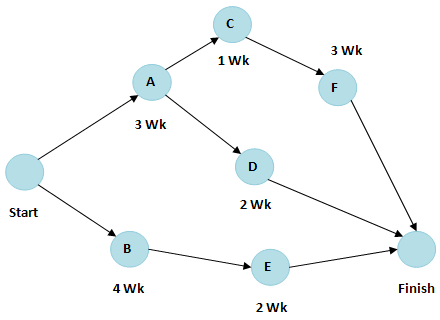Critical Path Method (CPM)
The critical path method (CPM) or critical path analysis is a technique developed by the DuPont Corporation in the 1950s for scheduling project tasks. It is based on graph theory (a mathematical concept), and is an important and widely used project management tool. CPM provides a graphical view of a project, predicts the time required to complete the project, and identifies the activities that are critical to maintaining the schedule, and those that are not. The project is modelled as a network, with activities shown as nodes on the network, and events that signify the beginning or end of activities depicted as lines (edges) between the nodes. A typical CPM network is illustrated below.

A typical CPM diagram
Steps in CPM project planning:
- Specify individual activities - essentially, produce a list of project activities (this can be derived from the work breakdown structure).
- Determine the sequence of activities - some activities can only begin once others have been completed. For each activity, determine what other task(s) must have been completed prior to commencement. These tasks are referred to as predecessors.
- Draw the network diagram - once the activities and the sequence of activities have been established, the CPM network can be drawn.
- Estimate the completion time for each activity - this will be an estimate, often based on past experience.
- Identify the critical path - the critical path is the longest path through the network in terms of the time required to complete the tasks that lie on it. Activities that lie on the critical path cannot be delayed without delaying the project.
- Update the CPM diagram as the project progresses - as actual task completion times become known, the network diagram can be updated to reflect this information, and a new critical path may emerge.
A delay in the critical path delays the project. In order to accelerate the project, it is necessary to reduce the total time required for the activities in the critical path. CPM is one of several activity network diagramming techniques, and provides a graphical view of the project activities, their interrelationships, and the tasks that lie on the critical path (and therefore need to be carefully monitored). CPM is ideal for projects in which there is relatively little uncertainty about project completion time or task duration. For projects of a more uncertain nature, the Project Evaluation and Review Technique (PERT) may be more suitable, since it allows a range of durations to be specified for each activity.
